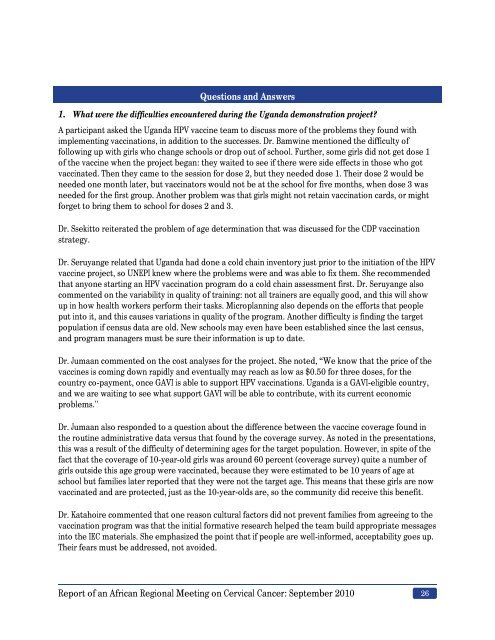Download file, English (1 MB PDF) - RHO
Download file, English (1 MB PDF) - RHO
Download file, English (1 MB PDF) - RHO
Create successful ePaper yourself
Turn your PDF publications into a flip-book with our unique Google optimized e-Paper software.
Questions and Answers<br />
1. What were the difficulties encountered during the Uganda demonstration project?<br />
A participant asked the Uganda HPV vaccine team to discuss more of the problems they found with<br />
implementing vaccinations, in addition to the successes. Dr. Bamwine mentioned the difficulty of<br />
following up with girls who change schools or drop out of school. Further, some girls did not get dose 1<br />
of the vaccine when the project began: they waited to see if there were side effects in those who got<br />
vaccinated. Then they came to the session for dose 2, but they needed dose 1. Their dose 2 would be<br />
needed one month later, but vaccinators would not be at the school for five months, when dose 3 was<br />
needed for the first group. Another problem was that girls might not retain vaccination cards, or might<br />
forget to bring them to school for doses 2 and 3.<br />
Dr. Ssekitto reiterated the problem of age determination that was discussed for the CDP vaccination<br />
strategy.<br />
Dr. Seruyange related that Uganda had done a cold chain inventory just prior to the initiation of the HPV<br />
vaccine project, so UNEPI knew where the problems were and was able to fix them. She recommended<br />
that anyone starting an HPV vaccination program do a cold chain assessment first. Dr. Seruyange also<br />
commented on the variability in quality of training: not all trainers are equally good, and this will show<br />
up in how health workers perform their tasks. Microplanning also depends on the efforts that people<br />
put into it, and this causes variations in quality of the program. Another difficulty is finding the target<br />
population if census data are old. New schools may even have been established since the last census,<br />
and program managers must be sure their information is up to date.<br />
Dr. Jumaan commented on the cost analyses for the project. She noted, “We know that the price of the<br />
vaccines is coming down rapidly and eventually may reach as low as $0.50 for three doses, for the<br />
country co-payment, once GAVI is able to support HPV vaccinations. Uganda is a GAVI-eligible country,<br />
and we are waiting to see what support GAVI will be able to contribute, with its current economic<br />
problems."<br />
Dr. Jumaan also responded to a question about the difference between the vaccine coverage found in<br />
the routine administrative data versus that found by the coverage survey. As noted in the presentations,<br />
this was a result of the difficulty of determining ages for the target population. However, in spite of the<br />
fact that the coverage of 10-year-old girls was around 60 percent (coverage survey) quite a number of<br />
girls outside this age group were vaccinated, because they were estimated to be 10 years of age at<br />
school but families later reported that they were not the target age. This means that these girls are now<br />
vaccinated and are protected, just as the 10-year-olds are, so the community did receive this benefit.<br />
Dr. Katahoire commented that one reason cultural factors did not prevent families from agreeing to the<br />
vaccination program was that the initial formative research helped the team build appropriate messages<br />
into the IEC materials. She emphasized the point that if people are well-informed, acceptability goes up.<br />
Their fears must be addressed, not avoided.<br />
Report of an African Regional Meeting on Cervical Cancer: September 2010 26
















